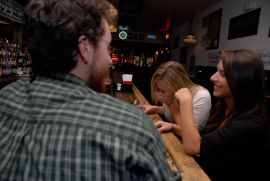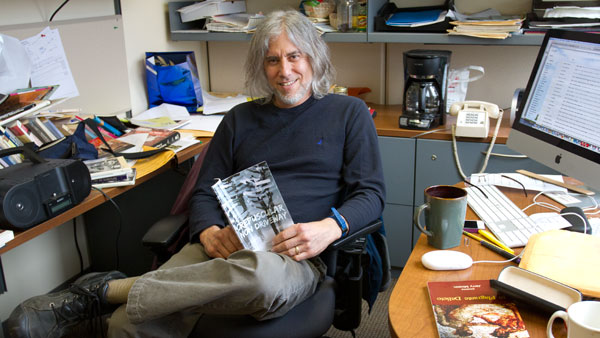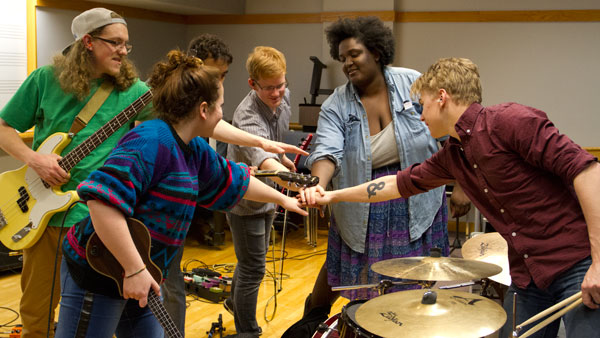It was another Friday night in Barcelona. Or was it a Saturday? Jon’s memory is a little off. It could’ve been a Tuesday for all he remembers. Jon, a senior at Ithaca College, was out with some friends on a pub crawl.

“We run into these two, just gorgeous, Danish girls,” Jon said.
He performed a magic trick, while his friend, operating as wing-man, started chatting the other girl up about Salvador Dali, of all things. By the end of the night, Jon kissed one of the girls, and the girls were buying the guys drinks.
“I don’t mince words … I did really well that night,” Jon said. “I had more success than I have ever been used to with a girl that attractive.”
Who knew that Salvador Dali and magic tricks were such big turns? Of course, the answer is a bit more complicated than that. Jon, like many frustrated guys out there, was using “The Game” — and for that night, at least, it worked.
Game doesn’t come naturally. It has to be taught, and the people who teach it are now part of a multi-million dollar industry. They go by many names, like love gurus and seduction scientists. But the most common name, the one popularized in books and on VH1 reality television, is “pick-up artists,” or PUAs for short.
PUAs call themselves artists because they believe they are skilled in the art of meeting, attracting and seducing a woman.
Jon is a fan of two of the most popular PUAs, the writer Neil Strauss and full-time pick-up artist Mystery.
Mystery, once an aspiring magician, is Erik von Markovik, the self-proclaimed “world’s greatest pick-up artist.” Mystery is as famous for his ability to promote himself as he is for wooing women and has parlayed his suavity in the nightclub into a pair of book deals and a reality television series. His one-time protégé, Rolling Stone and New York Times writer Strauss — known in the seduction community as “Style” — wrote a massively popular book of his own, “The Game,” which explores the community of pick-up artists and is soon to become a movie.
Professional pick-up artists train what are called AFCs, or “average frustrated chumps.” These “chumps” are schooled in a variety of tactics to be employed in the club, at the gym, at the office or really wherever their pick-up artistry suits them best. One such tactic is the “neg,” a slightly insulting comment, such as, “I like your nails. Are they real?” to help make the woman view the man as superior. “Peacocking” is another practice, in which a male wears an intentionally
ridiculous outfit to attract attention. These tactics’ success rates vary.
“It’s like anything else,” Jon said. “It’s tons of failures to succeed. I’ve gotten straight rejections before. But the thing about realizing your personal confidence is you don’t care about rejection anymore.”
For Jon, pick-up artistry is more than just getting girls. He views it as a part of human nature.
“If you’re a guy, I mean, that’s the purpose of a guy. To mate, to a certain extent,” Jon said. “Which sounds crass, but that’s what you’re genetically programmed for.”
Rebecca Plante, assistant professor of sociology, has studied the psychology of “hooking up” and looks at pick-up artistry, like the kind Mystery teaches, as a clever illusion similar to a magic trick.
“It makes total sense that he would package it up and say, ‘Look. I’m going to sell the illusion and the mind tricks necessary to you — who on first glance appears to have zero going for you, but … [then] you can do a little mind trick on some chick,” Plante said. “Because they’re always chicks. They’re not ladies or women. They’re chicks.”
Which begs the question: Is there anything inherently sexist about the idea that there is some secret formula which, if unlocked, could overpower even the most cunning female on the dance floor?
Junior Sarah Brylinsky, vice president of IC Feminists, is hesitant to say that there’s something sinister about pick-up artistry, but she doesn’t feel it’s totally innocent either.
“It’s definitely manipulation,” Brylinsky said. “To presume that all women are available receptors to the throws of some pick-up artist’s passion, like, that’s a pretty big presumption to make.”
Jon doesn’t consider structured pick-up lines to be any worse than attraction tactics already in popular use.
“What in gender dynamics isn’t manipulative?” he said. “If a girl wears a low-cut halter top, makeup, you know, that’s manipulative. When a guy wears a nice club shirt, that’s manipulative. It’s all about putting your best foot forward.”
Jon adamantly believes pick-up artistry is not sexist.
“I do think it assumes that all women are looking for the same thing,” he said. “But it’s not women. It’s human behavior.”
He views the game as more of a lifestyle-changing thing and a philosophy, not a guide to getting girls.
“[It’s] realizing that you have the power within you,” he said. “That you can have the confidence to do and say what you want to anyone and not have to worry about ‘Oh, she’s a 10. She’s out of my league.’ … That’s really freeing.”
Books like “The Game” and Web sites like www.theseductionbible.com are first and foremost about picking up girls. Picking up girls, getting some digits and if all goes according to plan, a little something extra. It’s not the end results, but the manipulation part that puts women off. Plante said it’s worth remembering that the Mysterys and Styles of the world haven’t been around forever.
“Through thousands of years in human history, all kinds of people have gotten laid,” Plante said. “And they all got laid without the benefit of pick-up artists or the Internet. People managed it.”





